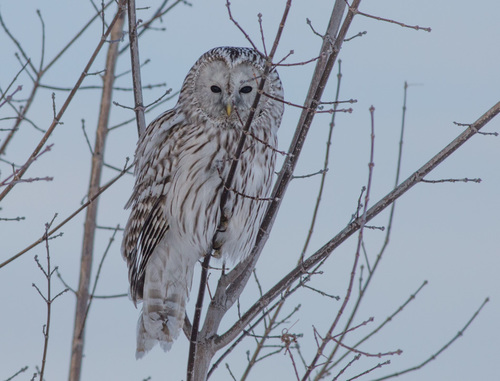
Ural Owl
The Ural Owl (*Strix uralensis*) is a large, nocturnal owl known for its distinctive appearance and significant ecological role in the forests it inhabits. It plays a crucial role as a predator, controlling populations of rodents and other small animals. While not globally threatened, it faces regional challenges related to habitat loss and fragmentation. The Ural Owl is not particularly well-known in popular culture, although it holds some significance in regions where it is more common, sometimes featuring in local folklore.
50-64 cm
Length
110-134 cm
Wingspan
Least Concern
Conservation Status
Distribution
The Ural Owl has a wide distribution across Eurasia, ranging from Scandinavia and Eastern Europe eastward across Russia to Sakhalin Island and Japan. It is also found in parts of Central Europe. It is generally non-migratory, although some populations may move short distances in response to severe winter conditions.
Lifespan
Up to 15 years in the wild, potentially longer in captivity.
Ural Owl's Habitat
Habitat Types
Mature forests, Mixed woodlands, Boreal forests, Taiga
Climate Zones
Temperate, Boreal
Adaptations
The Ural Owl prefers dense forests with clearings or edges for hunting. It often nests in areas with old-growth trees, which provide suitable cavities or platforms. Their feathered legs and feet provide insulation in cold climates.
Variations
Several subspecies of Ural Owl are recognized, differing slightly in size and plumage coloration. These variations are often linked to geographic location, with some subspecies adapted to the specific environmental conditions of their region.
Appearance
Breeding Plumage
Plumage is generally consistent throughout the year, without significant differences between breeding and non-breeding seasons.
Seasonal Feather Changes
No major seasonal variations.
Sex Based Plumage Differences
Males and females have similar plumage, although females may be slightly darker in some populations.
Notable Features
Large, round head without ear tufts., Pale facial disc with dark concentric rings., Relatively long tail., Pale greyish-brown plumage with dark streaks.
Diet and Feeding
Primary Foods
Small rodents (voles, mice), Small birds, Frogs, Insects
Foraging Behavior
The Ural Owl is primarily a nocturnal hunter, using its excellent hearing and low-light vision to locate prey. It often hunts from a perch, swooping down silently to capture its target.
Specializations
Like other owls, the Ural Owl has facial discs that help to funnel sound to its ears, enhancing its ability to detect prey in low-light conditions. Its soft feathers allow for nearly silent flight.
Seasonal Diet Variations
Diet may vary slightly depending on prey availability. During winter, when rodents are less active, the Ural Owl may take more birds.
Behavior
Social Structure
Ural Owls are generally solitary or found in pairs, especially during the breeding season.
Communication
Territorial hooting, Contact calls between pairs, Alarm calls when threatened
Migration
Generally non-migratory, but some individuals may move short distances in response to food availability or severe weather.
Territorial or Group Behaviors
Ural Owls are highly territorial, especially during the breeding season. They will aggressively defend their nesting territory from intruders, including other owls and potential predators.
Conservation
Threats
Habitat loss and fragmentation due to logging and deforestation, Collision with vehicles, Electrocution on power lines
Protection Programs
Habitat preservation and restoration efforts, Monitoring of populations, Awareness campaigns
Local National Laws
Protected under various national and international laws, including the EU Birds Directive.
Population Trend
Stable
Population Estimates
The global population is estimated to be between 500,000 and 1,499,999 mature individuals.
Interesting Facts
Ural Owls are known for their aggressive defense of their nests.
They will readily attack humans or other animals that approach too closely.
They can rotate their heads up to 270 degrees.
This allows them to have a wide field of view when searching for prey.
Their flight is almost completely silent.
Specialized feathers with soft edges help to dampen the sound of their wings, making them stealthy hunters.
Faqs about Ural Owl
What is the biggest threat to Ural Owls?
Habitat loss and fragmentation are the primary threats to Ural Owl populations.
Are Ural Owls dangerous to humans?
While generally not aggressive, they can be dangerous if their nest is approached. They will fiercely defend their young.
Where can I see a Ural Owl?
Ural Owls are found in mature forests across Eurasia. They are most active at night, so spotting one can be challenging.
Copyright @ Nature Style Limited. All Rights Reserved.
 English
English